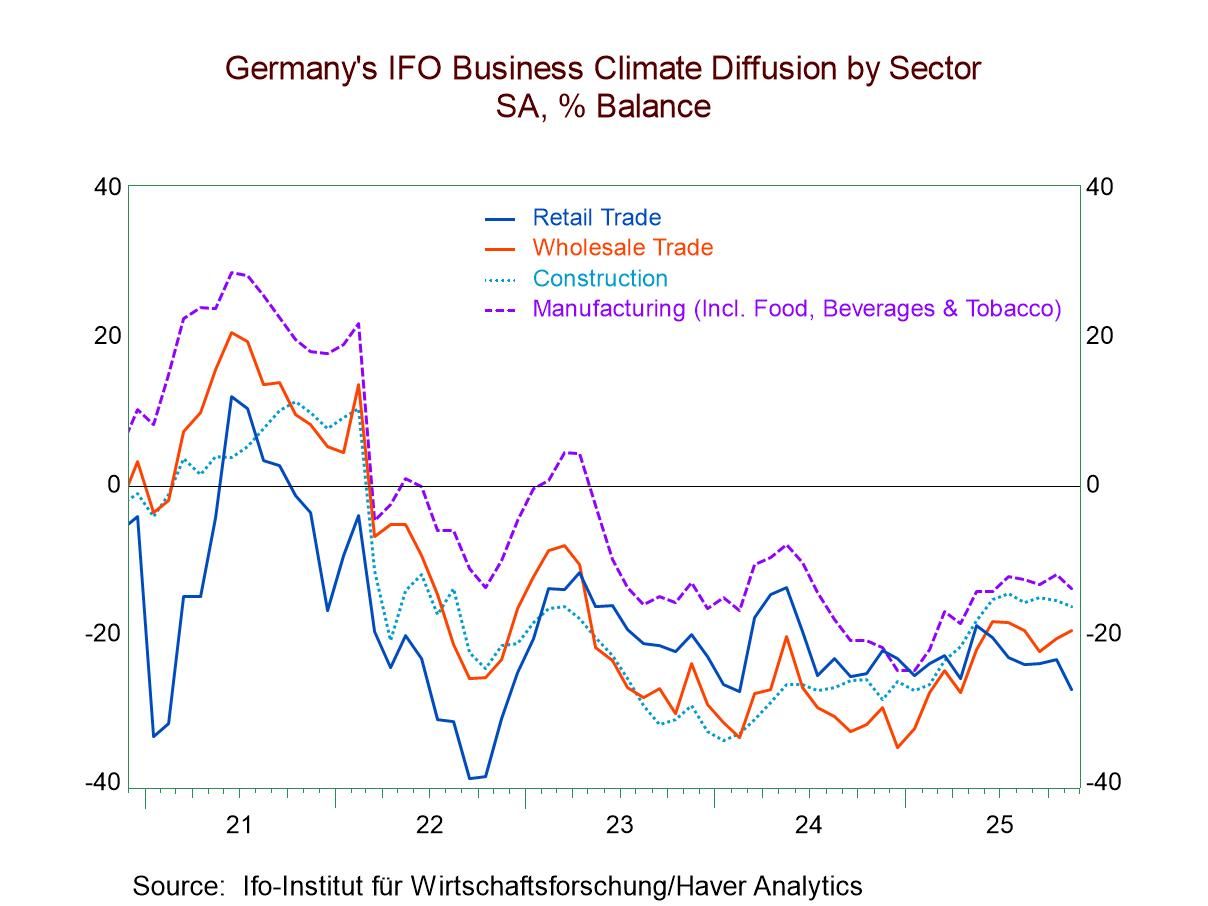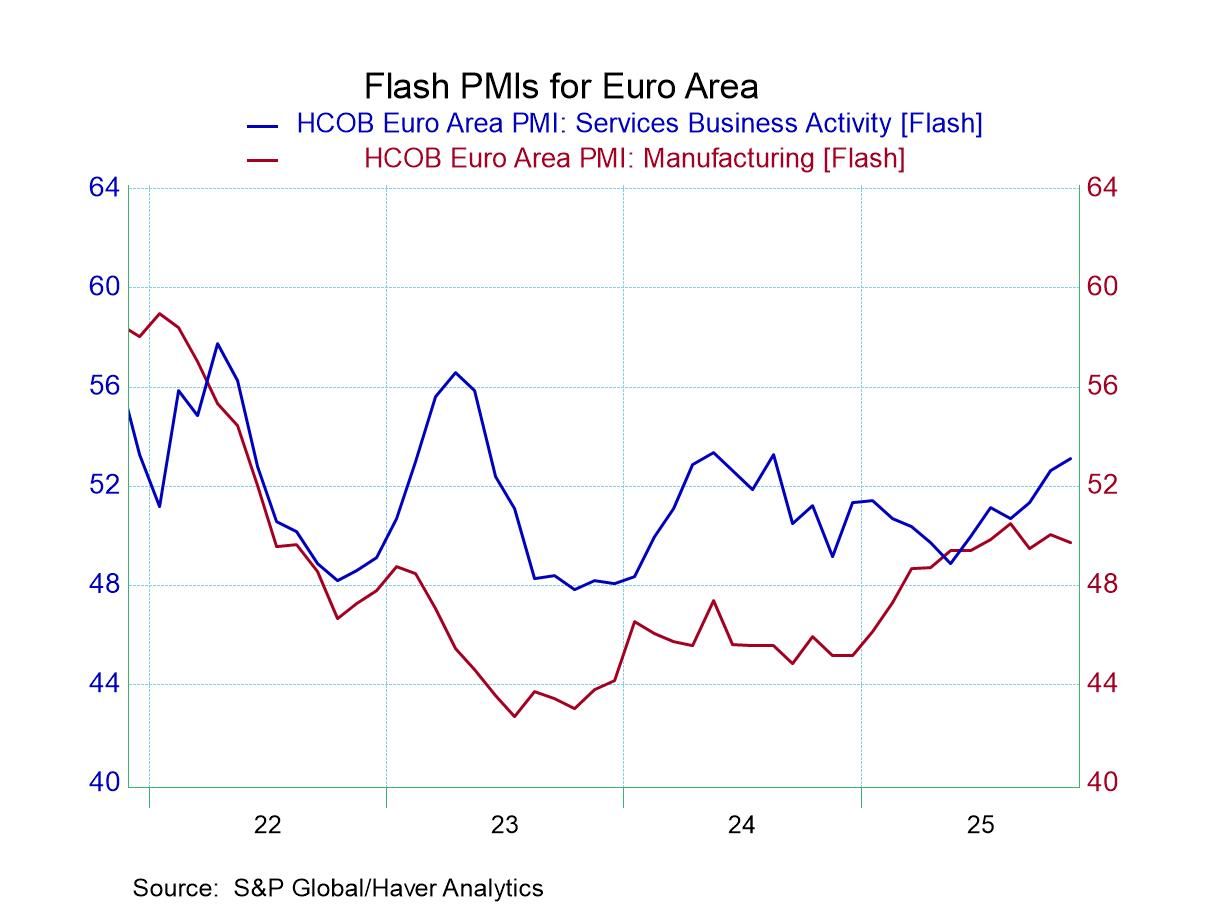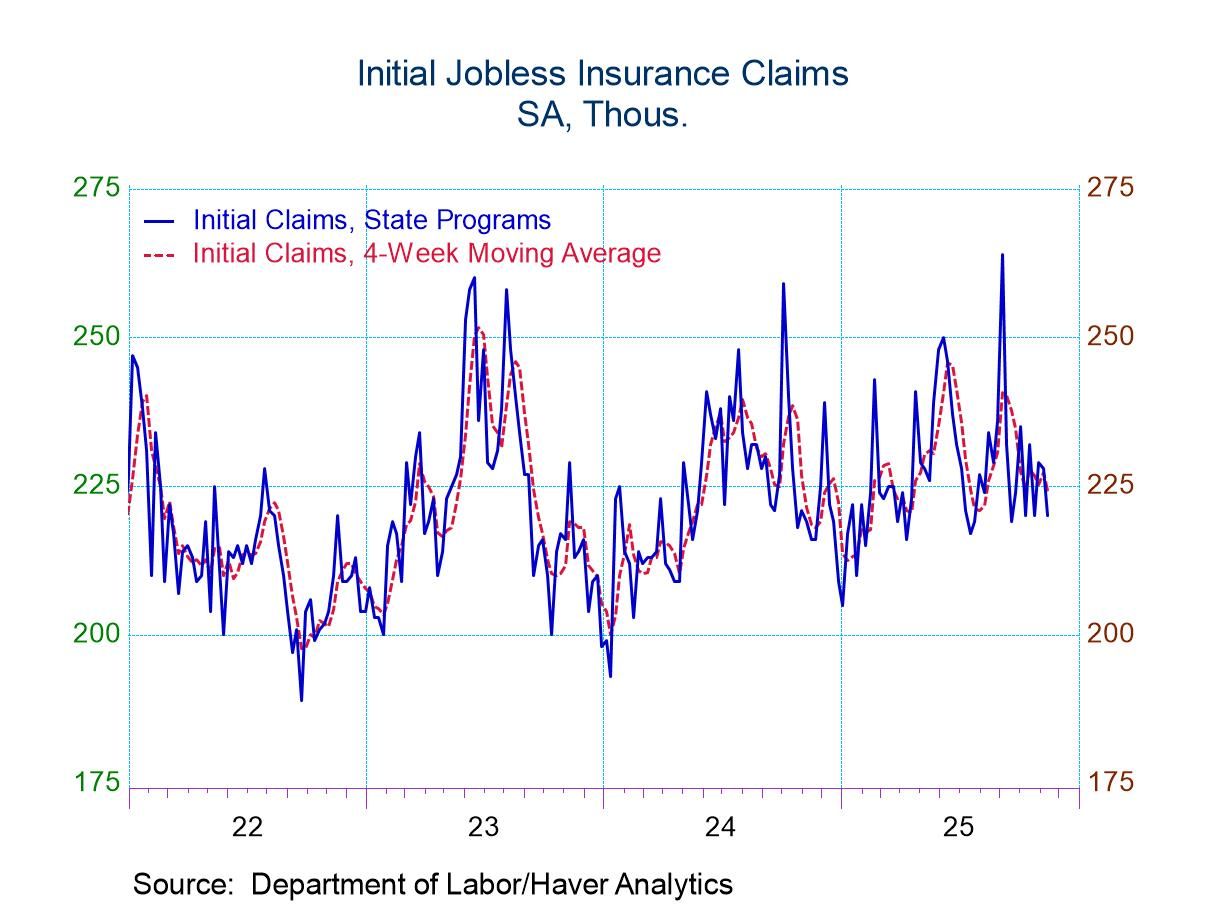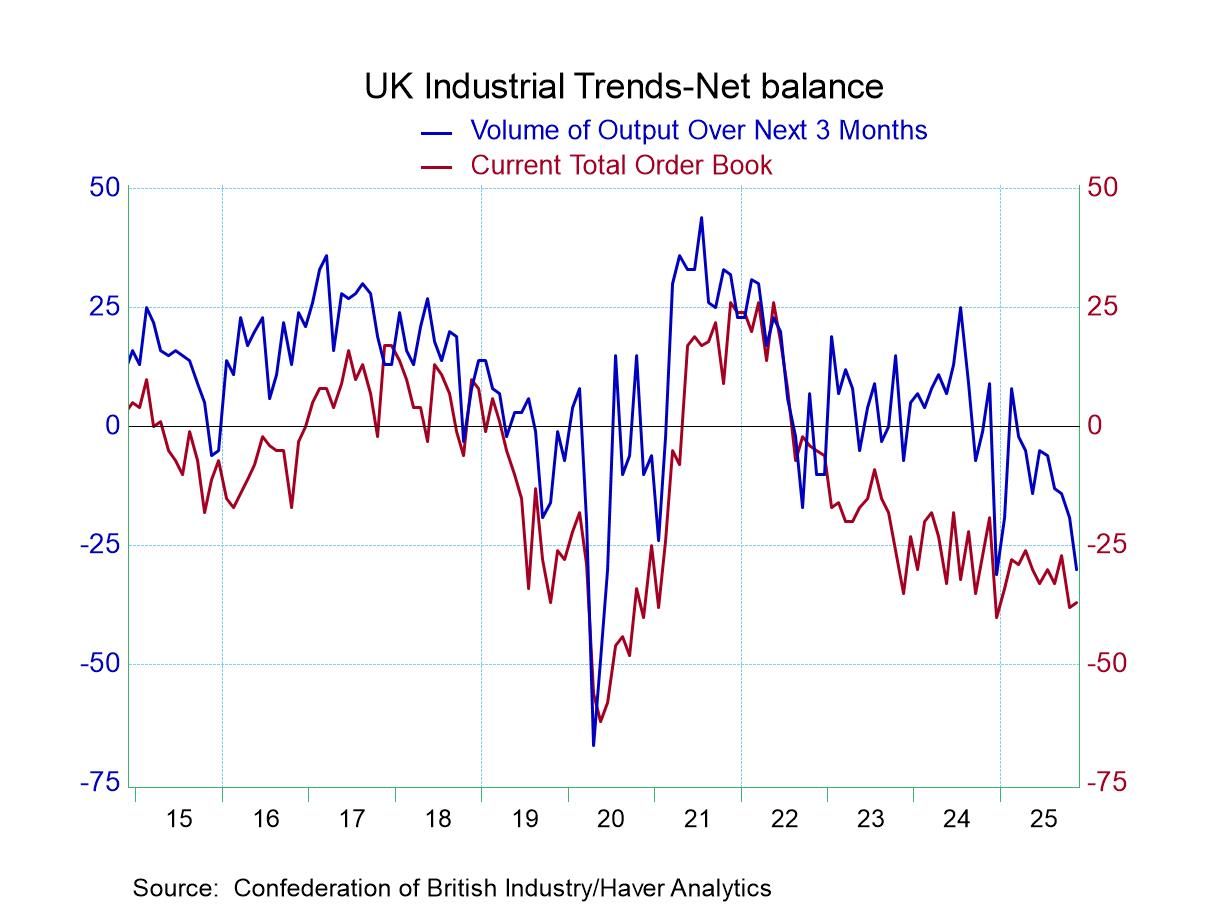- General Business Activity down in Nov. to -10.4, lowest level since June.
- Company Outlook (-6.3) negative for the third straight mth. and at a five-month low; Production (20.5) at a four-month high.
- New Orders Growth (-1.3) still negative, but New Orders (4.8) turns positive after two negative readings.
- Employment (1.2) positive for the sixth time in seven mths.
- Prices Received up 3.1 pts. to 10.8; Prices Paid up 1.9 pts. to 35.3.
- Future General Business Activity up to 11.0, a three-month high.
- USA| Nov 24 2025
Texas General Business Activity Remains Negative in November, But Expectations Stay Positive
- Germany| Nov 24 2025
IFO Expectations Drop in Germany
Germany’s IFO climate gauge fell in November logging a -16.5 net diffusion score after -14.6 in October. The overall index for climate ranks in its 18.4 percentile on data back to the early 1990s. Among the five key sectors that the table illuminates, only one, construction, has a ranking above 50% which puts it over its median for the period. Manufacturing is at a 13.6 percentile standing, retailing is at a 14.1 percentile standing, services are at a 16.8 percentile standing, and wholesaling is at a 26.9 percentile standing - all of these quite weak.
More on Climate.... On a month-to-month basis, climate eased lower for the headline, manufacturing, construction, and retailing. There were month-to-month improvements in wholesaling, as it improved slightly to -19.4 in November from -20.5 in October and then services where a ‘zero’ reading in October crept up to a 0.5 positive reading in November.
Current Conditions The current conditions metric for the IFO improved slightly to -5 in November from -5.6 in October. Improvements were pretty much across the board in all sectors with the exception of retailing that fell relatively sharply to a -20.9 reading in November from -16.6 in October. Once again, the percentile standings for these five sectors - this time for current conditions - show all of them below their historic median except for construction at a 62.1 percentile standing. The overall current index has a 10.4 percentile standing
Expectations...not so great expectations... Expectations in this report weakened across the board with the headline moving to -10 in November from -8 in October. Manufacturing deteriorated particularly sharply falling to -7.1 in November from -2 in October. All sectors weakened, most of them with more modest month-to-month deterioration. The queue ranked standings for the all-sector reading is at the 21.9 percentile mark. Most of the sectors have a 20 to mid-20 percentile standing; the exceptions are construction with a 30.7 percentile standing and retailing with the very weak 7.9 percentile standing
Summing up The weakening in the IFO index this month was unexpected. While current conditions were broadly getting slightly better, expectations took a significant step back in the month, raising questions about how the German economy is doing and what sorts of readings we're going to see next month afterward given this unexpected turn of events for the worse.
- Textile and metals prices continue to strengthen.
- Crude oil prices rise.
- Framing lumber costs decline again.
by:Tom Moeller
|in:Economy in Brief
 Global| Nov 21 2025
Global| Nov 21 2025S&P PMI Gauges are Mixed but Improving
The month-to-month changes in the S&P PMI indices are mixed in November with slightly more of them weakening than strengthening but still quite a significant mix and the European monetary union the composite index weakened, dragged lower by a weakening in manufacturing while the services index improved. The services in EMU improved for three months in a row but manufacturing deteriorated for two months in a row before sinking in November.
Germany and France separately report early from the monetary union. Germany shows weakening across the board for all three sectors while France shows strengthening in the composite and in services only showing a weakening in manufacturing.
The United Kingdom shows weakening the composite and in services with strengthening in manufacturing. That pattern is repeated in Australia.
Japan shows improvement in all three sectors and shows consecutive improvement only in the composite index.
India shows weakening in the composite and in manufacturing with only services strengthening in November after all three sectors weakened in October.
The US, after seeing all three sectors weaken in September, then strengthen in October, shows the stronger composite and stronger services in November juxtaposed to a weaker manufacturing reading.
The monthly data create a great deal of turbulence and create a picture that's hard to pin down in terms of trends and generalities. However, the three-month, six-month, and 12-month average data provide a much more solid and stronger framework. That sequence is not only stronger but it's much more solid in terms of the message that it sends. The period averages which are calculated only on completed data (so these are data through October) show only three-sectors (out of 24) weakening that's France for the composite, and France for services, and Japan for manufacturing; the other six countries or areas all show sector readings improve for the three-month average compared to the six-month average. Six-month averages compared to 12-month averages show only a weakening in Australia for manufacturing. 12-month averages compared to 12-months ago show weakening in only 8 separate sectors involving five different regions. Year-over-year comparisons show the UK is weaker in all sectors, Japan is weaker for the composite and for services, the European Monetary Union, Germany, and France are weaker on their 12-month average only for the services sector.
Percentile standing The queue percentile standings for the eight countries in the table reveal readings below the 50% mark for only three of 24 sectors those 3 sectors are the UK composite, UK services, and manufacturing in Japan. All the rest have standings above the 50% mark which puts them above their historic medians on data back to January of 2021.
The standing data are substantially improved from what we're seeing just a few months ago there is a general improvement in the global economy as is clear from the average data although the monthly data are still quite touch and go.
Summing up The November report is disappointing because prior to its release there had been relatively solid trends in place. It's now going to be important to keep an eye on the monthly data to see if this improving trend remains or if we've entered a period where signals are going to get mixed again. There's some evidence of some scattered weaknesses, particularly in the UK economy, that's performing poorly, there, the central bank is likely to deliver another rate reduction soon. The situation in the European monetary union is much more in flux. The US is also in ‘no-man’s-land’ on jobs and inflation, but in the United States the difference is that GDP growth has been strong and appears to continue to be strong on the back of investment an artificial intelligence and in data centers. The US continues to report out weak job growth, essentially because of special factors related to structural demographic conditions, a closed border, deportations, legacy effects from a closed government, (which have now been reversed) and what may be ongoing weakness caused by a transition from firms that are phasing in their artificial intelligence investment. Every economy has a story. The US story may stave off rate cuts through year-end.
- USA| Nov 20 2025
U.S. Payroll Employment is Unexpectedly Firm in September; Earnings Rise Steadily, but Jobless Rate Edges Up
- Hiring improves broadly.
- Construction, private services & government jobs rise, but factory employment declines.
- Earnings improvement is steady y/y, but slows m/m.
- Unemployment rate moves higher as job growth lags labor force gain.
by:Tom Moeller
|in:Economy in Brief
- USA| Nov 20 2025
Existing Home Sales: A (Faint) Pulse
-Sales rose for the third time in the past four months… -…but activity remains low by historical standards
- USA| Nov 20 2025
Unemployment Claims: Modest Changes
- Initial claims remain range bound at a low level
- Continued clams are drifting upward
- United Kingdom| Nov 20 2025
CBI Industrial Survey Seeing Ongoing Weakness and Deterioration Ahead
The survey of the industrial sector by the Confederation of British Industry (CBI) shows ongoing weakness for orders and export orders as stocks build slightly more aggressively. The build out in stocks when orders and expectations for volume are falling is not a good sign and suggests that the inventory buildup may be involuntary and that may be setting the stage for weaker economic performance ahead.
Total orders in November notch a reading of -37 on the net diffusion reading, about the same as the -38 logged in October. Both of those are significantly weaker than September's -27 and compare to a six-month and 12-month average around minus 32 and minus 33.
Export orders are improved in November but still quite weak at a reading of -31 compared to -46 in October. At -31 the November net reading for exports is similar to the six- and 12-month averages which are -32 and -33, respectively.
Stocks of finished goods in November have moved up to +16 from +7 in October they were higher than the 12-month average and the higher than the six-and 12-month averages, the latter 2 hovering around values of 10 and 12 compared to this month's value of 16.
An accelerating weakening appears, looking ahead for output volume over the next three months. The reading drops to -30 in November from -19 in October and -14 in September; the 12-month average stands at -13 with the six-month average of -15. This is a severe deterioration
Average prices over the next three months, however, as expected output volume deteriorates sharply in November is expected to see less pressure. The November value for prices in 3-months at a reading of +7 compares to score if +16 in October. At +7 the price expectations are well below the 12-month average which has been 18 and the six-month average which checks in at +13. With economic cooling expected, cooling in price pressures are expected to accompany that slow down.
Standings by the numbers: The queue standings of the November variables are uniformly weak. The exception is stocks of finished goods which have a 74-percentile standing displaying strength in that measure while orders and expected output volume are weak as a bad sign. Average prices, while losing some momentum in November, still have a standing at their 53.7 percentile, slightly above their median- so these are still somewhat heated price readings although the pressure is off compared to October and compared to 6-month and 12-month standards. Total orders have a 9-percentile standing; export orders have a 26-percentile standing and the expectation for output volume over the next three months has only a 2.8 percentile standing.
The activity and expected activity portions of the survey remain very weak. Their results support the idea that the economy may need more help from the Bank of England despite some ongoing inflation overshoot. As mentioned in yesterday's write up the inflation metrics are beginning to converge toward values that the Bank of England will find more acceptable although the current levels of variables measuring inflation are still too high. The momentum is in the right direction and with economic weakness in train, it's hard to imagine the Bank of England holding the line or standing on ceremony because inflation is still above target. The economy is beginning to emit signs that are a more significant outcry for help.
- of2683Go to 7 page









